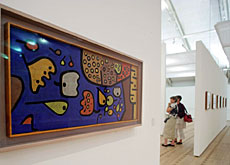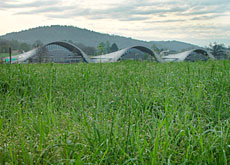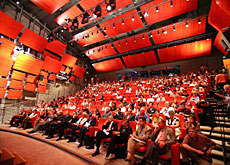Paul Klee Centre opens to the public

A new centre in Bern to honour the artist Paul Klee has opened its doors to the public, more than eight years after the first plans were laid.
With over 4,000 works, the Paul Klee Centre holds one of the largest collections of pieces by a single artist worldwide – but the establishment is more than just an art gallery.
Designed by star architect Renzo Piano, the building – in the form of three undulating waves – also houses a music and performance venue as well as a children’s museum.
Erected by the city and canton of Bern – where Klee spent half his life – the new building was made possible thanks to a donation of funds and land from the Maurice and Martha Müller Foundation. Klee’s family also played a crucial role, donating to the centre their share of works inherited from the artist.
The official opening takes place on Tuesday when there will be a symbolic handover of the building from the Müller Foundation to the Paul Klee Centre Foundation.
Last-minute preparations
Press officer Nathalie Gygax said that staff at the centre had worked virtually around the clock in the two weeks preceding the opening to ensure everything was ready for the big day.
“We are convinced that everything will work perfectly,” she told swissinfo ahead of the opening.
Gygax said last-minute preparations had included tests of fire equipment and evacuation procedures. “We’re prepared for all scenarios,” she added.
The press officer said staff had absolutely no idea how many people to expect when the museum opened its doors, but were prepared for a massive influx.
“A maximum of 500 persons can go in to see the collection. To reduce waiting times we have activities in the Museum Street [linking the three hills] and outside the centre.”
Obstacles
The centre and its supporters had a number of political, financial and cultural obstacles to overcome before its opening.
In 1990 Klee’s daughter in law Livia and his grandson Alexander, offered the Bern authorities the works they had inherited. In return, they asked the city to build a museum dedicated to Paul Klee by 2006 at the latest.
After seven years of tough negotiations, agreement was finally reached.
The authorities at first thought of housing the museum in the former school where Klee was educated. They also considered a purpose-built construction.
But in July 1998 these plans were thrown into disarray with the announcement that a Bernese doctor, Maurice Müller, and his wife Martha had given the authorities SFr30 million ($26.4 million) towards the cost of the project, as well as a piece of land valued at SFr10 million on the eastern outskirts of the city.
A number of conditions were attached to the offer. One was that the museum had to be built on this piece of land, located near the Müllers’ home and close to the spot where Paul Klee was buried.
Another was that the Müllers wanted to be able to choose the architect themselves.
A huge controversy broke out. Finally, the cash-strapped city and cantonal authorities accepted the offer and the conditions attached.
The Maurice and Martha Müller Foundation was founded to oversee the project.
Three hills
In December 1998 Piano was charged with drawing up a design for the centre.
One year later, the internationally recognised architect presented his design for the new building: three constructions in the shape of hills with a wave-like roof.
Members of the centre’s administration were able to move into the first building in November 2004.
Shortly afterwards, the Paul Klee Foundation also moved out of its rooms in Bern’s Kunstmuseum and into the new centre.
swissinfo
Renzo Piano’s building cost SFr110 million to construct.
It comprises three hills of steel and glass, connected by a 150-metre thoroughfare known as “Museum Street”.
The exhibition space covers 3,000 square metres.
The collection includes 4,000 paintings, watercolours and drawings, archives and biographical material.
In addition, the centre houses a music and performance venue, children’s museum and seminar rooms.

In compliance with the JTI standards
More: SWI swissinfo.ch certified by the Journalism Trust Initiative


You can find an overview of ongoing debates with our journalists here. Please join us!
If you want to start a conversation about a topic raised in this article or want to report factual errors, email us at english@swissinfo.ch.